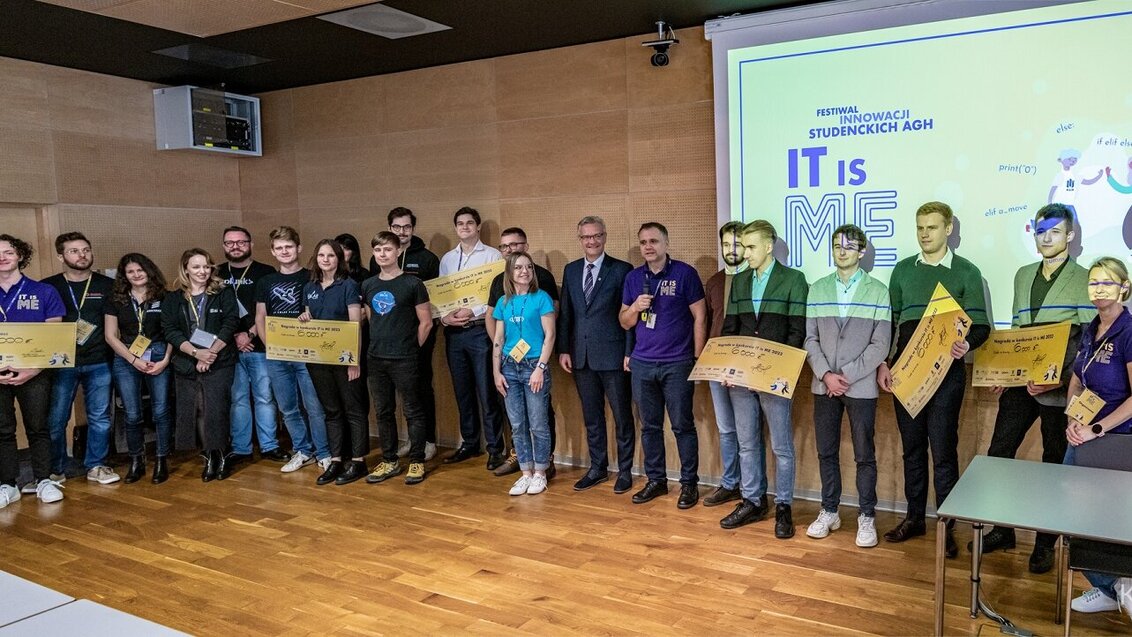How to use information technology in a practical, socially useful, and innovative way? The answer to this question is certainly known to the AGH University students whose projects proved to be the best in the IT is ME competition. The winning solutions are presented below.
HARteam – monitoring the activity of elderly people
Authors: Michał Kieres, Kasper Kornak, Wiktor Kwapniewski; Faculty of Mechanical Engineering and Robotics
The project’s objective is to improve the safety and quality of life of the elderly by monitoring their activities. It is mainly aimed at elderly people and their families, caregivers, or medical personnel. Owing to the solutions provided by IoT (Internet of Things) and AI (artificial intelligence), the system enables not only data collection, but also real-time interpretation. Those who care for elderly people can receive immediate notifications of changes in their activities and take quick action in case of emergencies (such as a fall). The developers of the solution also thought about respecting sensitive data – only specific activities are monitored, and information that could violate users' privacy is omitted.
Rescue Mission
Authors: Krzysztof Pęczek, Katarzyna Wcisło, Dariusz Królicki, Maksym Boiar, Izabela Kręc; Student Research Club Solar Plane at the Faculty of Energy and Fuels
A monitoring system based on an unmanned solar aircraft, the task of which is to detect people in a designated area and transmit information about their position to the drone. The drone, in turn, is tasked with helping a person in need. In an example scenario, the aircraft would be responsible for finding missing persons at sea, while the drone's task would be to drop a lifebuoy. The project is aimed at emergency services, search and rescue teams moving in a difficult or inaccessible terrain. In addition, it can be used to monitor large-scale facilities such as power plants and military training grounds.
Neural controller for piloting an unmanned aerial vehicle
Author: Jan Kostecki, Faculty of Electrical Engineering, Automatics, Computer Science, and Biomedical Engineering
The solution using the skills of experienced pilots will "teach" the autonomous aircraft to fly. The author of the project built a composite model of an airplane with a wingspan of two meters, on which he placed photovoltaic cells as an additional power source. He then prepared an electronic flight controller module and a ground base station connected to an application for analysis and configuration. This allowed for collecting data from regular flights and train the neural network to replicate the pilots' behaviour in the air. People involved in building and testing model airplanes or their applications can benefit from the possibilities provided by the project.
Monitoring the condition of a structure with the use of guided waves
Author: Grzegorz Zych, Faculty of Mechanical Engineering and Robotics
The solution combines the latest advances in acoustics, materials engineering, and digital signal processing. Thanks to the technology of guided acoustic waves, it is possible to accurately detect even small changes in the structure of the material, which allows for a faster reaction in case of potential damage. A key component of the device are highly sensitive piezoelectric transducers, which convert mechanical vibrations into electrical signals for real-time analysis and interpretation. In turn, the acoustic emission testing technology makes it possible to monitor the sounds emitted from the material under the influence of possible damage. This can be an invaluable indicator of material degradation or impending failure. The solution can benefit companies in the space industry, research institutions, manufacturers of monitoring equipment, and, in the long term, the construction and industrial sectors.
Design of a new cylinder for S-38 engine and development of a technology for its creation
Author: Adrian Dąbrowski, Faculty of Foundry Engineering
Using 3D design, computer simulations of engine operation, and liquid alloy casting, the AGH University student developed a technology for casting the engine cylinder. Beneficiaries of the solution can be foundries prototyping parts as well as individual customers who want to minimize casting costs.
***
The IT is ME Competition is organised within the AGH University Student Innovation Festival. Its main purpose is to promote the scientific and innovative potential of the AGH University students and to provide a platform for presenting their achievements to a wider audience, including IT companies. This year’s edition took place on October 26 at the Faculty of Computer Science.
The authors of the projects submitted to the competition had to, among other things, list the IT technologies used, demonstrate the innovativeness of the solutions, identify the group of beneficiaries, and determine the components of the project's maintenance costs and commercialization opportunities.
In evaluating the competition entries, the following were taken into account: innovative use of information technology and advanced IT tools, social utility and practicality of application, level of technological sophistication, and ability to be implemented quickly.
The head of the jury was professor Aleksander Byrski from the Faculty of Computer Science.
The winners of the competition received monetary prizes.

 Pre-election meeting with a candidate for the position of rector
Pre-election meeting with a candidate for the position of rector  Agreement on cooperation with OPAL-RT
Agreement on cooperation with OPAL-RT  Krakow DIANA Accelerator consortium members with an agreement
Krakow DIANA Accelerator consortium members with an agreement  Meeting with the Consul General of Germany
Meeting with the Consul General of Germany  More Academic Sports Championships finals with medals for our students
More Academic Sports Championships finals with medals for our students  Professor Jerzy Lis re-elected as AGH University Rector
Professor Jerzy Lis re-elected as AGH University Rector  Launch of AGH University Student Construction Centre
Launch of AGH University Student Construction Centre  Bronze for our swimmers at Academic Championships
Bronze for our swimmers at Academic Championships